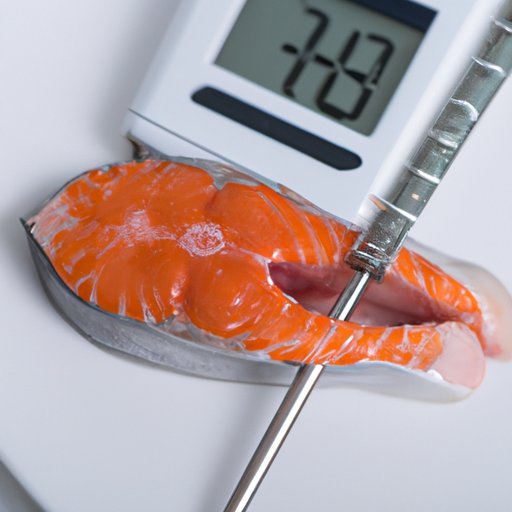
Introduction
Salmon is a delicacy that can be prepared in numerous ways. From baking to grilling, there are many ways to cook salmon, but determining when it is fully cooked can be tricky. Knowing when salmon is cooked is important, not only from a taste perspective but also for safety reasons. Undercooked salmon can cause food poisoning. In this article, we will provide a beginner’s guide on how to know when salmon is cooked to perfection.
A Beginner’s Guide to Cooking Salmon: How to Tell When It’s Done Just Right
Salmon can be cooked to different levels of doneness, including rare, medium-rare, medium, and well-done. Cooking salmon to perfection is a blend of timing and technique. There are diverse methods for cooking salmon, including baking, grilling, poaching, or pan-frying. While the specifics are different for each cooking method, the principles of determining doneness hold fast, whether you are a pro chef or a home cook.
5 Foolproof Methods to Check If Your Salmon is Cooked to Perfection
To determine if your salmon is fully cooked, there are several foolproof methods you can safely employ.
Method 1: Using a food thermometer is one of the most accurate methods of testing doneness. Insert the thermometer into the thickest part of the salmon fillet, and if it reads between 125-140°F, your salmon is fully cooked.
Method 2: Cutting into the thickest part of the salmon with a knife is another way to test doneness. If the flesh has turned from a translucent pink to a more opaque shade of pink, it is cooked all the way through.
Method 3: Testing for “flakeyness” is another way to check if your salmon is fully cooked. Gently push the flesh with a fork, and it should flake easily without resistance.
Method 4: Checking for color can also help in determining doneness. Look for a uniform, glossy, and golden-brown color on the surface of the salmon.
Method 5: Using the “touch test” is another way to test if your salmon is fully done. Gently touch the surface of the fish – if it bounces back, the salmon is likely undercooked, while if it feels firm, the salmon is fully cooked.
The Ultimate Salmon Cooking Guide: Testing for Doneness
The thickness of the salmon, cooking temperature, and cooking method all influence how long it takes for salmon to cook. Follow these guidelines to ensure perfect results every time:
Baking: Set the oven at 350°F and cook salmon for 12-15 minutes per inch of thickness. Check for doneness using a fork, thermometer or the “touch test.”
Grilling: Preheat the grill to medium-high and grill the salmon for 6-8 minutes per side, or up to 10 minutes per inch of thickness. Test for doneness with a fork, thermometer, or the “touch test.”
Poaching: Place the salmon in simmering water and cook for 8-10 minutes or up to 12 minutes per inch of thickness. Check for doneness using a fork or thermometer.
Pan-frying: Fry the salmon in a skillet over medium-high heat for 3-4 minutes per side, or up to 5 minutes per inch of thickness. Check for doneness by cutting into the thickest part of the salmon with a knife.
When the Heat is On: Expert Tips for Knowing When Your Salmon is Cooked
Here are some additional tips from the pros on how to tell if salmon is cooked:
Using your senses: Good salmon should have a mildly fishy aroma and should not smell overly “fishy.” Good quality salmon should have vibrant orange or pink flesh.
Understanding the texture: A properly cooked salmon fillet should have a slightly springy texture and should hold its shape, yet flake easily.
Common mistakes to avoid when cooking salmon include overcooking it, adding too many seasonings, and cooking it on a too-high heat.
Beyond the Timer: How to Spot the Telltale Signs That Your Salmon is Fully Cooked
Relying solely on cooking time to determine doneness can be misleading. For a more accurate read, your eyes will be your best gauge. You should look for signs such as:
White protein: While cooking, you may notice white protein starting to rise to the surface of the fish. When fully cooked, this protein will solidify and become more visible.
Translucent juice turning opaque: When the salmon is done, the juices will start to solidify and become slightly opaque
Conclusion
Knowing when salmon is done is crucial to serving safe and delicious meals. Whether you prefer baked, grilled, poached, or pan-fried salmon, understanding the principles of determining doneness and applying accurate techniques showcased in this post will make you a better chef. So, the next time you want to make your best salmon recipe, refer to this guide and elevate your salmon cooking skills.





